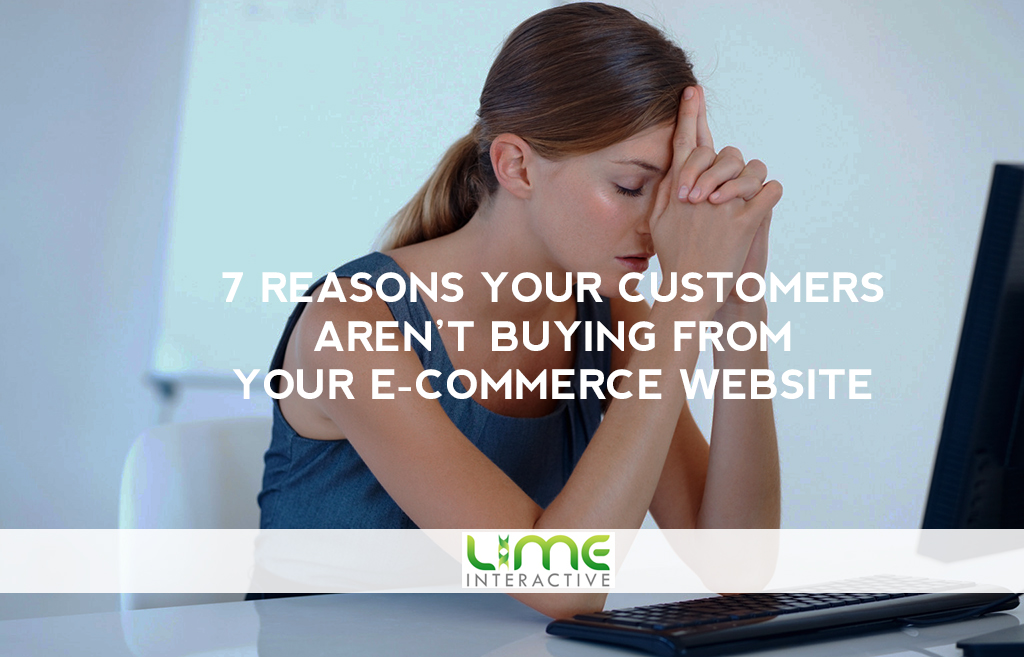7 reasons your customers aren’t buying from your e-commerce website
Frustrating, isn’t it? When your e-commerce store records lots of traffic, but still people aren’t clicking on the buy now button. Lots of people report traffic to their website, but for some reason this traffic does not convert to sales. Some even go as far as completing their contact details only to abandon their purchase at the last minute.
It is often a mystery to the company owner, and while a company owner cannot force a person to purchase, they can do their best to minimise unnecessary drop offs. In this article we look at common reasons that may be deterring customers from purchasing on your e-commerce website:
1- The products are hidden somewhere in the website
When was the last time you asked some friends to click through your website and observed their behaviour? This simple challenge can reveal problems with navigation immediately. Most business owners have been through redrafts of a website with a web designer multiple times by the time it is launched, so their point of view is often tainted by familiarity. They know how to navigate the site, because they’ve played a role in its design. Independent user testing is essential to gain an insight into navigation issues.
For a website, the easiest is the best: the navigation should be fluent and natural. Allow large blank spaces to give breathing room to the site and don’t be afraid of blank space. Remember to make the navigation agreeable. Limit the number of clicks to the minimum from the choice of the article to the payment; if the customer has to go through 5 pages before paying, he may exit your site instead. Your website must be comfortable and load quickly as remember a competitors’ website is always only one click away!
Navigation of an e-commerce store is a little more complicated than of a normal brochure website, due to the amount of potential product categories. Make sure you organise your items by family of products and don’t forget to offer an option to search by brand if you have several brands on your website.
Products listed under “Sale”, “New in” and “Best sellers” should also be highlighted, as these can act as real incentives to buy.
2- People do not trust buying from your website:
Customers need a lot of trust when buying online. They have to trust in the security of the payment but also trust in the quality of the product and the reliability of the shipping.
People often buy things online for upcoming events or as a gift, so timing is everything. If they’re working to a deadline and they don’t trust you’ll deliver, they’ll definitely exit your store without purchase.
Adding reviews to your site are an excellent way to build trust. Ideally, instead of approaching customers to generate reviews, you should have it built into the store that they can rate their experience themselves. These reviews are much more authentic, and they force you to be on your game with delivery as if you get a bad review your score will drop! If you’re using a wordpress website, there are lots of review plugins you can purchase. To get your first twenty or so reviews, you could offer some store credit as an incentive to create the review (to protect yourself from being wrongly accused of bribery, make it clear that you’re offering them credit for a review – regardless of whether its positive or negative).
Nothing is better for a brand image than the testimony of a buyer who had a good experience with the brand. But when you get them, where do you place them? The answer is simple: everywhere! Well, almost. They should be present every time the customer might be in doubt, on the product’s page to reassure on its quality, on the payment step, and after the payment, to leave the customer in a good state of mind.
3- Customers are just “looking around” your website
For some products, such as cars or holidays, many people stay on the market for months before purchasing (the average is six months in the case of cars). With clothes and home decor, people are known to purchase impulsively. Its good to try and find out how long the average person considers a product in your particular industry as this will help you to understand why certain people aren’t buying – they could be just at the browsing stage.
However, that’s not to sat you can’t influence a sale. The objective here is to push them into a purchase. In such a situation, your marketing material has to be compelling enough to make up the customer’s mind and buy your products. Here are some means to convince them:
- Create supporting content that gives them advice and based on the choices of previous similar customers share them items they could like. Make clear recommendations about the products through supporting articles, for example; an unusual scarf that can be worn many ways will sell much better if it is accompanies by an article with pictures demonstrating its diversity. You can also segment the audience and create guides for which products are appropriate for which type of person. If you can create tailored pages or guides for your different types of customers, then fantastic. When people are considering purchasing, they have a massive appetite for reading, looking at photos and watching videos about your products as it give them added assurance.
- Second tip: keep their track with emails. Set your website up to automatically email anyone who has given their email information but hasn’t completed the sale. The email should remind them of their purchase intent and should also allow them to come back after having considered the idea of buying. Following that initial contact, regular newsletters will also help you keeping contact with them.
- Be clear about your returns policy. A good returns policy can improve sales so let them know how easy it is to return their products.This way, customers fear of being ‘trapped’ with an item they do not really want will be diminished.
4- They found a better price on another website:
Your customer can find the same product you are selling at a better price on another website. Shopping around has never been easier. In such a case you have to point out the benefits the customer will have from buying with you. He has to find an “added-value” that you must highlight on your website, as a particular element that could make the difference in his intention of purchasing. It can be in relation to the shipping that is quicker, or cheaper. Alternatively, try enhancing the brand image so that people feel great about purchasing your product and will be prepared to spend more. Tell your company story in a compelling way so people feel a connection and you stand out in the crowd. Try to build a sense of community around your products, and encourage online interaction amongst customers, so that people get the sense that buying from you is an experience worth paying for.
5- Items are presented with unexpected costs:
Because the price of shipping and other charges were not taken into account until the last minute, the global price of your customer’s basket suddenly increases at the moment he is going to the payment step. Lots of abandonments happens there, and this is often as a result of misinformation on the website.
To counteract this, your customers have to know early during their browsing how much the shipping is. Make sure all the shipping variables are communicated as soon as possible, to avoid this common mistake.
6- The payment method on your e-commerce website is too complicated.
If there are too many steps to achieve in the payment method, the customer might be discouraged into purchasing his goods. A key rule here is simplicity.
First of all, do not force her to create an account or sign in on your website, it might be time-losing for him and he does not want to have account on every website. Then, keep in mind that a checkout should be around 3 or 4 pages. Beyond these 4 pages, it starts becoming annoying for your customer. Try to limit the number of fields to 30 maximum, and make it easier with the possibility of auto-populating content. If you’re not happy with how simple your payment method is then perhaps you need to consider changing merchants – there are always new options on the market so research regularly.
7- The payment method on your e-commerce website doesn’t seem secure enough
On the contrary, do not skimp on the security in a fear of losing customers with a long checkout. You can always bring customers back to your website if they found it too long while it is more difficult to restore their confidence after a problem in the payment stage. Make the safety logo visible, in the form of the SSL certification or a padlock. And again, more previews from previous customers can be comforting in the payment decision.
To summarise, in order to prevent abandonment your e-commerce website needs to be a combination of great branding, trust-building content, easy navigation, correct product categorisation and security. Customers want a simple, seamless shopping experience, but achieving simplicity often requires an incredible amount of planning.

